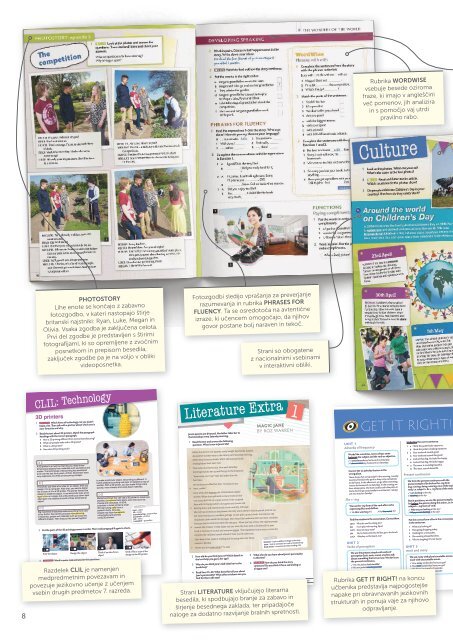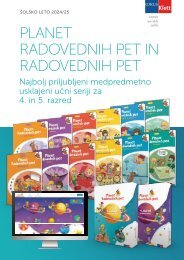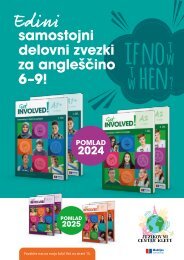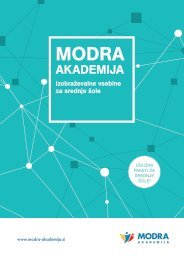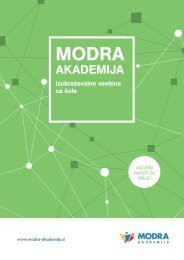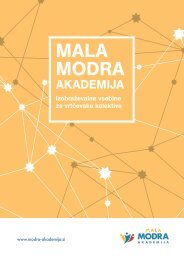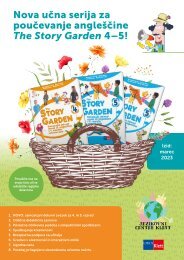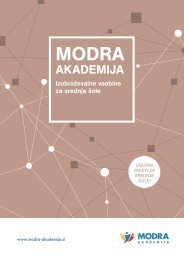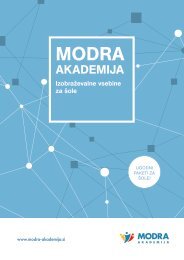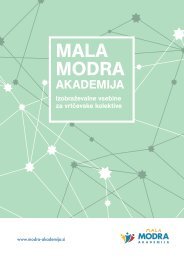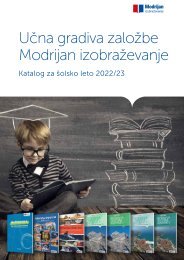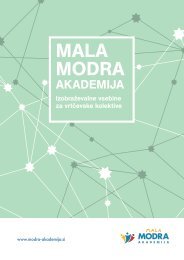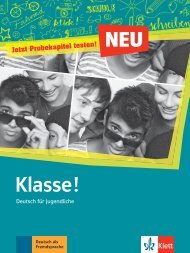Think
Create successful ePaper yourself
Turn your PDF publications into a flip-book with our unique Google optimized e-Paper software.
114<br />
Rubrika WORDWISE<br />
vsebuje besede oziroma<br />
fraze, ki imajo v angleščini<br />
več pomenov, jih analizira<br />
in s pomočjo vaj utrdi<br />
pravilno rabo.<br />
SPEAKING<br />
Priložnosti za razvijanje govornih<br />
spretnosti in tekočega govora prek<br />
dela v paru ali skupini so posejane<br />
po celotnem učbeniku. V vsaki lihi<br />
enoti pa je še stran DEVELOPING<br />
SPEAKING, ki sledi fotozgodbi in<br />
je posvečena razvoju govornih<br />
spretnosti.<br />
Lihe enote se končajo z rubriko<br />
CULTURE, v kateri učenci berejo o<br />
načinu življenja v drugih državah in<br />
kulturah, o njem razmišljajo in ga<br />
primerjajo s svojim. Besedila v tej<br />
rubriki so opremljena z zvočnimi<br />
posnetki. Naloge, ki sledijo<br />
besedilu, razvijajo sposobnost<br />
sklepanja in širijo besedišče.<br />
WRITING<br />
Pomembna značilnost serije <strong>Think</strong> je pristop<br />
k razvoju pisnega sporočanja. Učence usmerja,<br />
da se ne osredotočajo le na vsebino besedila,<br />
temveč da razmišljajo tudi o svojih razlogih za<br />
pisanje in o ciljni publiki. Pisno sporočanje je<br />
zastopano v dveh oblikah: v lihih enotah učenci<br />
pišejo krajša besedila na obravnavano temo, sode<br />
enote pa vsebujejo daljši razdelek, ki učence korak<br />
za korakom vodi skozi proces pisanja. Najprej<br />
se srečajo z vzorčnim besedilom, s pomočjo<br />
katerega se seznanijo z namenom pisanja in<br />
jezikovnimi strukturami, ki jim bodo prišlev prav<br />
pri izdelavi njihovega lastnega besedila, nato pa<br />
še sami napišejo besedilo po vzoru.<br />
PHOTOSTORY<br />
Lihe enote se končajo z zabavno<br />
fotozgodbo, v kateri nastopajo štirje<br />
britanski najstniki: Ryan, Luke, Megan in<br />
Olivia. Vsaka zgodba je zaključena celota.<br />
Prvi del zgodbe je predstavljen s štirimi<br />
fotografijami, ki so opremljene z zvočnim<br />
posnetkom in prepisom besedila,<br />
zaključek zgodbe pa je na voljo v obliki<br />
videoposnetka.<br />
Fotozgodbi sledijo vprašanja za preverjanje<br />
razumevanja in rubrika PHRASES FOR<br />
FLUENCY. Ta se osredotoča na avtentične<br />
izraze, ki učencem omogočajo, da njihov<br />
govor postane bolj naraven in tekoč.<br />
Strani so obogatene<br />
z nacionalnimi vsebinami<br />
v interaktivni obliki.<br />
Vsaki drugi enoti sledi stran<br />
s ponovitvijo TEST YOURSELF, ki<br />
učencem omogoča, da preverijo<br />
svoje znanje slovnice, besedišča in<br />
funkcijskega jezika preteklih dveh enot.<br />
CLIL: Technology<br />
3D printers<br />
1 SPEAKING Which items of technology can you name?<br />
Make a list. Then talk with a partner about which one is<br />
your favourite and why.<br />
2 Read the text about 3D printers. Match the paragraph<br />
A<br />
headings with the correct paragraph.<br />
1 How is 3D printing different from normal manufacturing?<br />
2 What can people make with a 3D printer?<br />
3 What is a 3D printer?<br />
4 How does 3D printing work?<br />
A 3D printer is a machine that lets you make threedimensional<br />
objects from materials such as plastics and<br />
metals. The technology of 3D printing has developed<br />
a lot over the last thirty years. At first, 3D printers were<br />
very expensive, but they are becoming cheaper.<br />
B<br />
First of all, you think of an idea for an object, then you<br />
design it on a computer. After that, you send a digital<br />
file or scan of it to a 3D printer. The printer follows the<br />
design to make the object. A normal printer puts a thin<br />
layer of ink on a page, but a 3D printer puts down layer<br />
after layer of a material to build a three-dimensional<br />
object.<br />
C<br />
Big machines in factories make everything from cars<br />
to toy bricks. We call this process manufacturing.<br />
In factories, people cut materials such as wood into<br />
different shapes. Then they put the pieces together<br />
3 Put the parts of the 3D printing process in order. Then read paragraph B again to check.<br />
the object Design the object <strong>Think</strong> of an idea for an<br />
Print object<br />
4 SPEAKING Work in pairs. Ask and answer the questions.<br />
Would you like to have a 3D printer at home? Why? Why not?<br />
What would you like to make using a 3D printer?<br />
to make a particular object. 3D printing is different. It<br />
builds objects by putting one layer of material on top of<br />
another. With a 3D printer, you can make things more<br />
quickly, more cheaply and using fewer materials.<br />
D<br />
Almost anything! You can use a 3D printer to make toys,<br />
jewellery, prosthetic body parts, even food such as<br />
cheese and chocolate. In 2019,<br />
scientists in Israel printed a small<br />
3D heart using cells from a<br />
patient’s body. One day,<br />
people may have transplants<br />
using body parts printed<br />
using 3D printers.<br />
a b c d<br />
102<br />
Razdelek CLIL je namenjen<br />
medpredmetnim povezavam in<br />
povezuje jezikovno učenje z učenjem<br />
vsebin drugih predmetov 7. razreda.<br />
GLOSSARY<br />
layer – plast<br />
ink – črnilo<br />
manufacturing – proizvodnja<br />
prosthetic – proteza<br />
cell – celica<br />
transplant – presaditev<br />
Send a file or scan of the<br />
design to the 3D printer<br />
Literature Extra<br />
Jane’s parents are divorced. Her father takes her to<br />
the bookshop every Saturday morning.<br />
1 Read the text and answer the following<br />
5<br />
10<br />
15<br />
20<br />
25<br />
question. What is new in Jane’s life?<br />
Before the divorce, her parents rarely bought Jane books. Instead,<br />
she and her mother went to the library each Saturday morning,<br />
where Jane chose ten books, which she'd always finish<br />
reading before their next visit.<br />
Then Jane’s dad moved out. Now each Saturday<br />
morning he picks her up and they go to the bookstore.<br />
“How many can I buy?” Jane had asked him the<br />
fi r s tt i me.<br />
He smiled and ruffled her hair. “As many as you<br />
want, cookie.”<br />
Each week, Jane browses the ‘intermediate reader’<br />
shelves. When she's gathered as many books as she<br />
can carry, she'll sit on a quiet stretch of the carpeted<br />
floor with its happy pattern of puppies and clowns and<br />
dancing mice, and examine each book carefully. Although<br />
she can buy as many as she pleases, she only wants them if they're special, and not, as<br />
her mom would put it, mindless garbage. As she picks up each book, she removes the<br />
tiny plastic disk tucked into its pages. She's heard the bookstore staff call them ‘chicklets’<br />
because they're small and white like the gum. When you buy a book, the register people<br />
remove the chicklet. If they forget and you leave the store with a chicklet still in your<br />
book, a loud alarm sounds and everyone stares. That happened to Jane once, so now she<br />
removes the chicklets herself, ahead of time, just to make sure.<br />
She's deep in her tasks of reading and choosing when her father<br />
comes to find her.<br />
“How's my little book worm?” he asks.<br />
2 How old do you think Jane is? Which details in<br />
the text help you guess her age?<br />
3 Why do you think Jane’s dad takes her to the<br />
bookshop?<br />
4 Read lines 15–20. What does this tell you about<br />
Jane’s personality? What other evidence can you<br />
find for this in the text?<br />
MAGIC JANE<br />
BY ROZ WARREN<br />
5 What else do you learn about Jane’s personality<br />
in this text?<br />
GLOSSARY<br />
browses – looks at different things in the shop<br />
stare – look at someone in a rude or shocked way<br />
book worm – someone who likes reading a lot<br />
6 SPEAKING How do you think the story<br />
1<br />
continues? Do you think it has a sad ending or<br />
a happy one?<br />
<strong>Think</strong> Level 1 Literature Extra 1 PHOTOCOPIABLE © Cambridge University Press 2017<br />
Strani LITERATURE vključujejo literarna<br />
besedila, ki spodbujajo branje za zabavo in<br />
širjenje besednega zaklada, ter pripadajoče<br />
naloge za dodatno razvijanje bralnih spretnosti.<br />
107<br />
UNIT 1<br />
Adverbs of frequency<br />
GET IT RIGHT!<br />
Words like sometimes, never, always come<br />
between the subject and the verb or adjective.<br />
✓ I sometimes do my homework on Saturday.<br />
✗ I do sometimes my homework on Saturday.<br />
Correct the six adverbs that are in the<br />
wrong place.<br />
I have always fun on Saturday! In the morning, I usually<br />
meet my friends in the park or they come sometimes<br />
to my house. In the afternoon, we go often swimming.<br />
I never do homework on Saturday. In the evening, we<br />
have always pizza. My mum usually cooks the pizza at<br />
home, but we go occasionally to a restaurant. I always<br />
am very tired on Sunday!<br />
like + -ing<br />
We use the -ing form of the verb after verbs<br />
expressing likes and dislikes.<br />
✓ He likes watching TV. ✗ He likes watch TV.<br />
Find five mistakes in the conversation. Correct them.<br />
LUCY What do you like doing, Jim?<br />
JIM I love play with my dog, Spud.<br />
LUCY Does he enjoy swim?<br />
JIM No, he hates swim. But he likes go to the beach.<br />
LUCY I like play on the beach, too!<br />
UNIT 2<br />
Verbs of perception<br />
We use the present simple with verbs of<br />
perception (look, taste, sound, smell) to talk<br />
about something that is true now. We don’t use<br />
the present continuous.<br />
✓ His new jacket looks terrible!<br />
✗ His new jacket is looking terrible!<br />
We use look, taste, sound, smell + adjective,<br />
NOT look, taste, sound, smell + like + adjective.<br />
✓ This pizza tastes awful!<br />
✗ This pizza tastes like awful!<br />
Underline the correct sentence.<br />
1 a I think this jacket looks expensive.<br />
b I think this jacket is looking expensive.<br />
2 a Your weekend sounds great!<br />
b Your weekend sounds like great!<br />
3 a Look at that dog. He looks like happy.<br />
b Look at that dog. He looks happy.<br />
4 a The music is sounding beautiful.<br />
b The music sounds beautiful.<br />
Present continuous<br />
We form the present continuous with the<br />
present simple of be before the -ing form<br />
(e.g. running, doing, wearing, etc.) of the main<br />
verb, i.e. subject + be + -ing form of the verb.<br />
✓ I am looking at the sky.<br />
✗ I looking at the sky.<br />
But in questions, we use the present simple of<br />
be before the person doing the action, i.e. be +<br />
subject + -ing form of verb.<br />
✓ Why are you looking at the sky?<br />
✗ Why you are looking at the sky?<br />
Put the correct form of be in the correct place<br />
in the sentences.<br />
1 What you looking at?<br />
2 They going shopping today.<br />
3 I looking for a new jacket.<br />
4 She wearing a beautiful dress.<br />
5 Why he laughing? It’s not funny!<br />
UNIT 3<br />
much and many<br />
We use many with plural countable nouns and<br />
much with uncountable nouns.<br />
✓ How many sandwiches have you got?<br />
✗ How much sandwiches have you got?<br />
✓ We haven’t got much cheesecake.<br />
✗ We haven’t got many cheesecake.<br />
Rubrika GET IT RIGHT! na koncu<br />
učbenika predstavlja najpogostejše<br />
napake pri obravnavanih jezikovnih<br />
strukturah in ponuja vaje za njihovo<br />
odpravljanje.<br />
PRONUNCIATION<br />
Vaje za izgovarjavo, ki so zbrane na<br />
koncu učbenika, se navezujejo na<br />
jezik obravnavane enote. Referenca<br />
na izgovarjavo nakazuje, na<br />
katerem mestu v enoti je obravnava<br />
izgovarjave najbolj smiselna.<br />
8 9


